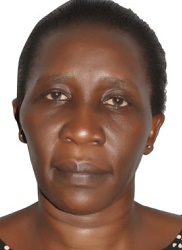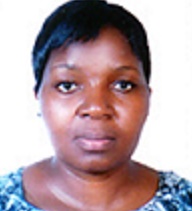
Dr. Cheptoris Lillian

Dr. Mariama Mustapha

JOSEPHINE NAMUJJU

Bitakwitse Lestine

Ms. Nakibuuka Noor Musisi

Lydia Kabwijamu

Dr. Namusoke Hellen

Grace Nantale

Dr. Edrako Immaculate Grace

Kanankunda Felicia

Ronald Nyakol

Teddy Iyogil

Ziyada Babirye
Dr. Cheptoris Lillian
Dr. Cheptoris Lillian is currently a postgraduate student persuing a masters in Paediatrics and Child health at Mother Kevin Postgraduate Medical school ,Nsambya, Nkozi University. She graduated from Mbarara University of science and technology and has been in clinical practice for the last 7 years.
SHORT TERM OUTCOME AND ASSOCIATED FACTORS OF PRETERM INFANTS ADMITTED IN ST. FRANCIS HOSPITAL NSAMBYA.
Background: Preterm birth burden is increasing worldwide and mortality due to preterm infant complications accounts for 27% of the 4 million neonatal deaths worldwide. In Uganda, premature deliveries contribute 13.6% of the total deliveries and 25% of neonatal deaths. Knowledge of the short term outcome of preterm infants is key in improving quality of care. However in Uganda, there is paucity of data on the outcome of preterm infants.
Objective: To describe the outcome and its associated factors among preterm infants admitted to St. Francis hospital Nsambya neonatal unit.
Methods: This was a prospective cohort study of 237 preterm infants, gestational age 24-36 weeks admitted to St. Francis hospital Nsambya between October 2015 and July 2016. These infants were followed up from admission to discharge or death. Data on maternal, infant characteristics and short term outcome were collected. Data was entered into the computer using Epidata version 3.1 and analyzed using STATA software package.
Results: Of the 237 preterm infants, 14% (n=33) died. Mortality according to gestational age categories was 86%, 27%, and 1% among the extreme preterm, very preterm and late preterm infants respectively. A total of 91% of those who survived had complications during the course of hospital stay. Respiratory distress (72%) and jaundice (50%) were the most frequent complications. The complications that were strongly associated with mortality were; intraventricular haemorrhage [COR 30(2.07-433.12), P-0.01] and late onset sepsis [COR 0.30(0.12-0.74) p-0.00]. The factors associated with mortality were lower gestational age and birth weight. Infants with Apgar score >7 and those born by caesarean section were found to have less odds of mortality, COR 0.17(0.07-0.41), p-0.00 and COR 0.34(0.15-0.80), p- 0.01 respectively.
Dr. Mariama Mustapha
Dr. Mariama Mustapha is a disciplined and confident medical doctor, and currently a third year student of Masters of Medicine in Paediatrics and Child Health in the Department of Paediatrics and Child Health, School of Medicine, Makerere University College of Health Sciences. She has organized and participated in various workshops, health projects, and skills training, while serving as the Vice President and National Exchange Officer of the Medical Students’ Association- Sierra Leone (MSA-SL), branch of International Federation of Medical Students’ Association (IFMSA). She has over five years of post qualification experience in maternal and newborn health working in various hospitals in Sierra Leone and Uganda. She is dedicated to becoming a champion in promoting maternal and newborn health in Uganda and beyond.
Dissertation Title: Utilization of prevention of mother-to-child transmission services by adolescent and young mothers attending Mulago Hospital
ABSTRACT
Background: Over 90% of HIV infection in children occurs through mother to child transmission (MTCT) of HIV. In order to eliminate Paediatric HIV infection, World Health Organization (WHO) recommends prevention of mother to child transmission (PMTCT) Option B plus (lifelong antiretroviral therapy for all pregnant and breastfeeding women living with HIV regardless of CD4 count or WHO clinical stage). In Uganda, 25% of girls have had a pregnancy by the age of 18 years. Moreover, adolescents have been noted to have poor utilization of health services. Adolescent and young mothers are therefore a vulnerable population which contributes significantly to shaping the future course of the HIV epidemic. However little is known about utilization of PMTCT services in this group.This study aimed to explore the utilization of PMTCT services by adolescents and young mothers attending Mulago National Referral Hospital, and to describe the factors that affect the optimal utilization of PMTCT services by these mothers.
Methods: This was an analytical and descriptive cross sectional study of 418 adolescent and young mothers, using quantitative and qualitative methods of data collection. An interviewer administered questionnaire was used to obtain information on maternal socio-demographic characteristics, HIV/AIDS and PMTCT-related knowledge, PMTCT utilization, and factors influencing utilization of PMTCT services. Twenty in-depth interviews with selected
adolescent and young mothers, and nine key informant interviews with health workers at the hospital were conducted to obtain an in-depth understanding of the context and factors influencing utilization of PMTCT services. Data was extracted and entered onto the Epidata version 3.1, exported and analyzed using STATA version 12. The overall proportion of participants who optimally utilized PMTCT services was determined using descriptive
statistics. The factors associated with optimal utilization of PMTCT services were determined by logistic regression. Qualitative data was analyzed manually using the content thematic approach.
Results: The median age of the mothers was 22 years (IQR 15-24 years). Of the 418 participants, 65 (15.5%) were HIV positive, and 353 (84.5%) were HIV negative. Only 30% (126/418) of the participants had optimally utilized PMTCT services. Utilization of PMTCT services was better among HIV positive mothers, with 83% (54/65) having utilized the services optimally, compared to only 20% (72/353) of the HIV negative mothers (p-value 0.001). Significant losses and delays occurred throughout the PMTCT cascade. The major reported factors motivating adolescent and young mothers to utilize PMTCT services included: the benefits of knowing ones HIV status, health of the unborn child, and counselling and support by health care staff. Stigma was the commonest reported barrier to adolescent and young mothers’ utilization of PMTCT services.
Conclusion: Optimal utilization of PMTCT services by adolescent and young mothers at 30% was low, especially among HIV negative mothers. Reported positive HIV status was significantly associated with optimal utilization of PMTCT services. The benefits of knowing ones HIV status, health of the unborn child, and counselling and support by health care staff were the major factors motivating adolescent and young mothers to utilize PMTCT services, while stigma was a key demotivating factor.
Recommendations: Special consideration should be given to adolescent and young women in the design of EMTCT programs, to improve the utilization of PMTCT services particularly among those found HIV negative at the first HIV test. Stigma as a barrier to the utilization of PMTCT services should be addressed. Counselling and health care support should emphasize on the benefits of PMTCT services since they motivate adolescent and young mothers to
utilize the services. More detailed studies should explore stigma and stigma prevention among this age group.
Contact: mamspha@yahoo.com
JOSEPHINE NAMUJJU
Josephine Namujju is a senior nursing officer and a holder of a Bachelor’s degree in Nursing and a Post Graduate Diploma in Public Administration. Josephine has completed a master’s program in Midwifery and Women’s Health from Makerere University and now awaits graduation.
Josephine has offered clinical services in the area of maternal and child health care and managerial roles for over 20 years in Mulago National Referral Hospital and various District local governments. She has developed her career from Nursing officer (midwifery) to Senior Nursing Officer since 2010 and now acting Assistant District health officer, Mbale district.
Dissertation Title: childbirth experiences and the derived meaning among postnatal mothers in Mbale Regional Referral Hospital, Mbale District.
Introduction: The proportion of women who have had negative childbirth experiences is 7- 16 % according to studies done in Sweden and Netherlands and might be higher in developing countries Uganda inclusive. Negative childbirth experiences cause undesirable effects such as failure to breastfeed, impaired relationship of the mother with the baby and psychological strains like mood disorders.
Objectives: In this study, the childbirth experiences and the meaning mothers attribute to their childbirth experiences were explored among postnatal mothers in Mbale Regional Referral Hospital.
Methods: A phenomenological qualitative study was done on mothers within 2 months after delivery. Data was collected by in depth interviews and focus group discussions, participants purposively selected and data were thematically analyzed.
Findings: Seven themes emerged: Childbirth pains: severity, duration and patterns were major concerns reported. Social orientation to labour pains provided encouragement. Service providers’ attitudes and care: caring, attention , listening to mothers, psychological support, and management of complications by service providers were noted positive while poor attention, non- listening, slapping, quarreling, roughness, poor communication, lack of psychological support, and failure to observe privacy were negative childbirth experiences reported. Social support: physical and psychological support provided comfort, consolation and encouragement to mothers. Childbirth fears: negativity of care providers, operations, unknown outcomes and complications were major sources of fear. Meaning attached to childbirth experiences: To individual mothers, it meant a strong and brave woman, determined, self confident, self belief and respect to a mother. Culturally, operated women were considered bewitched, weak and failures while vaginally delivered women considered brave and strong. Birthing environment: labour wards were reported to be clean, with inadequacies in supplies and beds while washrooms were dirty and agonizing. Spirituality: women prayed, held on to God for help and gave thanks to Him after birth.
Conclusion: Childbirth experiences were unique, elicited unique feelings, responses and challenges thus the need for proper assessment and understanding of a mother as an individual, coupled with positivity of a service provider for a positive childbirth experience.
Contact: mwanjejose@yahoo.com
Bitakwitse Lestine
BITAKWITSE LESTINE is a psychologist with Masters in Health Services Research from Makerere University College of Health Sciences. Lestine has experience in research implementation (team leadership) and quality improvement at facility and community levels in projects funded by WHO, USAID, UN and MOH. Currently, her interests lie in health systems strengthening, research and disease surveillance.
Dissertation title: Determinants of health facility based delivery among women in urban slums of Kampala Uganda.
ABSTRACT
Background: High maternal and neonatal mortality is still a public health concern in low income countries. And pregnant women inhabiting urban slums are high risk group with limited access to health facilities. In Uganda utilization of ANC is quite high at 95% but health facility based births is low at 57%.
Objective: The study examined the frequency and determinants of facility based deliveries among women in urban slums of Kampala.
Methods: A mixed methods study design with both quantitative and qualitative methods was used. In the cross-sectional study design, multistage sampling was used to select a total of 420 mothers who had delivered in the past one year preceding the survey. A pre-tested interviewer administered questionnaire and Focus Group Discussion guide were used with women aged 15-49. Stata 10 software was used to analyze the quantitative data. Ordinary Logistic regression was used at multivariable analysis to determine independent predictors in utilization of health facilities at delivery. Qualitative data analysis was done manually using content analysis to code the responses into sub-themes and themes as some of the reported statements were quoted verbatim to give exact meaning.
Results: Over all, the utilization of health facility based births was 66.1% and ANC attendance was 95.7%. The factors that significantly influenced facility based delivery among urban poor were exposure to media OR 2.5(1.6-3.9), frequency of ANC attendance for less than 4 times OR=0.6 95% CI (0.3-0.9) and timing of first ANC visit in the 2 and 3rd trimesters of pregnancy OR 0.5 95% CI (0.3-0.8). From FGDs the factors commonly highlighted by mothers as facilitators to health facility based delivery are free cost of care and nearby public health facilities. However, barriers included poor reception and handling of laboring mothers, lack of privacy, poor competence and attitudes of health workers, lack of facility equipment or materials, hidden cost of care, limited transport options and too many supplies required at delivery like gloves and baby clothing’s.
Conclusion and recommendations; This study demonstrated that utilization of maternal health services (antenatal and delivery services) were relatively high in the study area. The most important factors influencing the use of health facilities at delivery are media exposure, timing of ANC, and frequency of ANC visits, facility and economic barriers. There is need to improve media exposure among mothers, promote health education programs on the benefits of early initiation of ANC, attending ANC at least four times, availing ambulances, change of health workers attitudes and improving facility equipment and materials.
Contact: bitslestine@gmail.com
Ms. Nakibuuka Noor Musisi
Ms. Nakibuuka Noor Musisi is a lawyer with special interest in Human Rights particularly advancing women’s health and related rights. I am pursuing a master of laws degree at Makerere University. I have done short courses in the struggle for health (by IPHU), Justiciability of the right to health (by OHCHR) creative activism, arbitration and reconciliation.
Noor works for Center for Health Human rights and Development (see www.cehurd.org) as a Program Manager. At CEHURD, I am responsible for program development and implementation; resource mobilization; Monitoring and evaluation; reporting; Main streaming Human rights based approach; Advocacy; representation, networking and partnerships. While here, I have been able to contribute to the realization of women’s rights in Uganda and holding the government accountable to such rights using different strategies.
Abstract
The efficacy of public interest litigation in realizing maternal health rights in Uganda: a case study of constitutional petition no. 16 of 2011
Guided by the major objective, “To explore the effectiveness of public interest litigation in realizing maternal health rights in Uganda”, the research presents findings from an analysis of a maternal health case, Constitutional petition No. 16 of 2011 and draws examples from jurisdictions that have excelled in using Public Interest Litigation to realize maternal health rights.I used qualitative methodologies including desk top review and key informant interviews with various stakeholders to analyze the case.
The study found the institution of the PIL case led to formulation of policies aimed at reducing maternal mortality, parliamentary passing of a maternal health resolution, and civil society activism and resultant budgetary increment in the health sector. It further revealed the filing of other PIL cases on maternal health such as Civil suit No. 111 of 2012, created awareness on maternal health rights including within the judiciary, although as a negative impact the case re-awakened the political question doctrine which might make it very difficult to litigate and realize maternal health rights in Uganda.
It is recommended that to advance maternal health rights through PIL, there should be a well thought out advocacy strategy to accompany PIL, need to include maternal health rights in Uganda’s Constitution, enforce national policies and guidelines as PIL alone cannot lead to realization of maternal health rights, ratify the optional protocols to international convention on economic social and cultural rights to enable advocates to pursue human rights claims directly before treaty monitoring bodies and use of persuasive decisions while litigating before the Justices of the court.
In conclusion, the recommendations from the study highlight the importance of PIL in realizing maternal health rights despite the fact that the case being investigated is still pending before court. It is thus imperative that study findings be widely disseminated for practitioners, academia, and researchers to understand the importance brought forward by the strategy in realization of rights.
Contact: nakibuukamusisi@gmail.com
Lydia Kabwijamu
Lydia Kabwijamu is a Social Scientist with a Masters in Public Health. She has previously worked with projects funded by CIDA, DFID and MOH to improve Maternal and Child health at community and health facility level. Her interest is in maternal, newborn and child health with special attention to adolescents.
Research:
She has completed her study which examined essential newborn care practices and associated factors among adolescent mothers.
Study Title: Newborn Care Practices among Adolescent Mothers in Hoima District, Western Uganda
Introduction: Adolescent childbearing remains a major challenge to improving neonatal mortality especially in Sub Saharan countries which are still struggling with high neonatal mortality rates. We explored essential newborn care practices and associated factors among adolescent mothers in Western Uganda.
Methods: Data were collected among 410 adolescent mothers with children aged one to six months in Hoima district. Three composite variables (appropriate neonatal breastfeeding, cord care and thermal protection) were derived by combining related practices from a list of recommended newborn care practices. Logistic regression analysis was conducted to identify factors independently associated with practice of essential newborn care.
Results: Appropriate newborn feeding, optimal thermal protection and dry cord care were practiced by 60.5%, 67.2% and 31% of adolescent mothers respectively. Independent predictors’ of cord care were: knowledge of cord care (AOR 5.34, 95% CI (1.51–18.84) and having delivered twins (AOR 0.04, 95% CI (0.01–0.22). The only predictor of thermal care was knowledge (AOR 25.15, 95% CI (7.01–90.20). Staying in a hospital for more than one day postpartum (AOR 2.45, 95%CI (1.23–4.86), knowledge of the correct time of breastfeeding initiation (AOR 14.71, 95% CI (5.20–41.58), predicted appropriate neonatal feeding, whereas; adolescent mothers who had had a caesarean delivery (AOR 0.19, 95% CI (I 0.04–0.96) and a male caretaker in the postnatal period (AOR 0.18, 95% CI (0.07–0.49) were less likely to practice the recommended newborn feeding.
Conclusion: Sub optimal essential newborn care practice was noted especially suboptimal cord care. Adolescent mothers should be a focus of strategies to improve maternal and neonatal health
Dr. Namusoke Hellen
Dr. Namusoke Hellen is a Postgraduate Student at Mother Kevin Postgraduate Medical School –Nsambya (Uganda Martyrs University) and a Graduate of Mbarara University of Science and Technology.Hellen has worked with St. Francis Hospital Nsambya –Uganda as a Medical Officer for one year and is interested in Emergency Paediatric Care (Newborn Health inclusive).
INCIDENCE, SHORT TERM OUTCOME AND FACTORS ASSOCIATED WITH HYPOXIC ISCHEMIC ENCEPHALOPATHY IN NEWBORNS DELIVERED AT ST. FRANCIS HOSPITAL, NSAMBYA
ABSTRACT
Introduction: Hypoxic Ischemic Encephalopathy (HIE) carries a high case fatality rate of 10 – 60% and at least 25% of survivors have an adverse long-term neurodevelopment outcome. However few studies have studied its magnitude, associated factors and short term outcomes in Uganda.
Objective: To determine the incidence, associated factors and short term outcome of HIE in Newborns delivered at St. Francis hospital, Nsambya.
Methodology: A prospective cohort study was conducted at St. Francis Hospital, Nsambya between 13th October 2015 and 19th January 2016. Inborn term newborn babies whose mothers consented to the study were enrolled. Umbilical cord arterial blood gas done was for newborns with low Apgar Scores at five minutes. A clinical examination was done on all participants for features of encephalopathy within 48 hours of life. Newborns with HIE were followed up by a daily clinical examination and short term outcomes were documented at one week of follow up.
Results: The incidence of Hypoxic Ischemic Encephalopathy was 30.6 cases per 1000 live births and among these, 56.5% had moderate to severe HIE. The factors significantly associated with HIE included: Referred mother (AOR :4.058,CL:1.0-15.7,P =0.043), Antepartum hemorrhage (AOR: 5.2,CL:1.0-26.2,P=0.045), Prime Parity (AOR: 3.2 CL:1.3-7.9, P =0.01), and history of herbal use (AOR :5.2,CL:2.1-13.4,P=0.048). A total of (6) 26% died and the majority (15) 65.2% of those with HIE were discharged without complications by day 7. The short term complications seen by day seven included: lack of a nutritive suckling reflex (nasogatric feeding), poor Moro reflex, and requirement for respiratory support (oxygen therapy by nasal prongs) among two participants.
Conclusions: The incidence of HIE at St. Francis Hospital, Nsambya was 30.6 per 1000 live births and 26% of the Babies with HIE died. .
Recommendation: Appropriate use of Partograph to monitor labor especially for prime gravida mothers. Early and timely referral of mothers with complications will reduce the magnitude of HIE as well as Newborn mortality
Contact: helennankya@yahoo.com
Grace Nantale
Ms. Grace Nantale is currently a Masters of Public Health Nutrition graduate at Makerere University School of Public Health and a fellow at the One Health Institute. She is particularly interested in maternal, child health and nutrition.
Grace is a nurse (BScN) with more than five years experience as a clinical nurse, research nurse and as a nurse educator. She has extensive experience in community health involving community health promotion activities such as sensitisation, capacity building of health workers and engagement of community leaders in the areas of reproductive health, maternal health and nutrition as well as HIV/AIDS.
Dissertation Title: Prevalence and factors associated with food insecurity among women aged 18-49 years in Makindye Division slums, Kampala District
Contact: gracenantale2002@yahoo.co.uk
Dr. Edrako Immaculate Grace
Dr. Edrako Immaculate Grace is a Medical Officer who is currently a resident of Paediatrics and Child Health in the College of Health Science Makerere University.
She is interested and concerned about the most vulnerable people in the society. She previously worked for more than ten years with organizations like Deutsche Gesellschaft für Internationale Zusammenarbeit (GIZ), German Development Service (DED) and African centre of torture victims where she served the children refugees and tortured victims. Edrako Immaculate defends these victims as expert witness in the human rights tribunal court in the course of standing for their rights.
She also worked in the Neonatal Intensive Care Unit where she was inspired to study Paediatrics and Child Health.She is passionate about making lasting difference for New Born Care, Child Health and the Child’s Rights.
Dissertation title: Short term outcomes of Term neonates delivered by Caesarean Section at Mulago Hospital, Uganda
Background: Uganda has the highest perinatal mortality rate in East Africa and is still short of the Millennium Development Goal (MDG) number four. Though there are many factors that account for this, it has been demonstrated in studies that cesarean section is protective in reducing perinatal morbidity and mortality. In Mulago National Referral hospital more than 90% cesarean section deliveries are done as an emergency. Emergency cesarean section is more likely to result in birth asphyxia and perinatal loss compared to elective cesarean and vaginal birth. The neonatal outcome of babies born by cesarean section at Mulago hospital is not known. This study describes the short term outcomes of full term neonates delivered by caesarean section and factors influencing the respective outcomes.
Methods: This was a prospective cohort study with a single arm carried out between August to December 2015 at the Mulago National Referral Hospital. All term neonates delivered by caesarean section and whose parents gave consent to participate were recruited into the study. Information regarding maternal medical, antenatal history, labor and birth outcomes was collected. The babies born were examined at birth and at five minutes for APGAR score, weight and physical examination. The babies were monitored for temperature, respiratory rate and random blood sugar at 6 hours and daily up to discharge or a maximum of seven days. The main outcomes were either a normal baby or a baby with any of the abnormal measurements or death. Data was entered using Epi-Data and analysed using STATA version 12. Results of the outcomes were presented as proportions and associated factors determined using multivariate analysis.
Results: A total of 305 live births participated in this study. Of this, 223 were well babies while 82 had atleast one abnormal neonatal outcome. The prevalence of poor outcome was 82/305, 27%. The commonest poor outcome was hypoglycemia (57/305, 19%) followed by birth asphyxia (39/305, 13%), respiratory distress (38/305, 12%) and hypothermia (6/305, 2%). The mortality was 4% (12/305). Mothers who had been referred for cesarean section were twice more likely to have babies with a poor outcome: Adjusted Odds Ratio (AOR) 2.74, 95% CI: 1.03 – 7.27, P=0.043. Emergency cesarean section, AOR 4.3, 95%CI: 1.25- 14.77, General anesthesia, AOR 12.75 95%CI: 1.63 – 99.59, P = 0.015 and antibiotic used in the third trimester AOR 4.75.95%CI,1.40-16.16. Delayed initiation of breastfeeding AOR, 23.05, 95%CI,11.85-44.82 was the only infant factor that was independently associated with a poor outcome.
Conclusion: One in four babies born by cesarean section had a poor outcome. The maternal factors that were independently associated with poor outcome were referral for caesarean, emergency cesarean section, general anesthesia and antibiotic used in the third trimester. Delayed initiation of breastfeeding was the only infant factor that was independently associated with a poor outcome.
Contact: iedrako@yahoo.com
Kanankunda Felicia
Kanankunda Felicia is a student at Makerere University, pursuing Masters Services Research. I have a Bachelor degree of Community Psychology Currently am carrying out my research about utilization of modern family planning methods among women living with HIV/AIDS at TASO Mbarara. My expectations for my study are to find out how modern family planning methods are utilized among women living with HIV/AIDS.
I am currently employed at Bishop Stuart University, where I work as an Assistant Lecturer in the department of public health, faculty of applied science for the last four years.
My passion for MNH is to be instrumental in helping policy makers and programme implementers to improve on resource allocation, improve on service delivery, plan better for mothers and their children which will help HIV/AIDS positive women to be able to have children they can manage to take care. This will also enable appropriate care for the children that are born.
Contact: fkanankunda@gmail.com
Dissertation Title: utilization of modern family planning methods among women living with HIV/AIDS at TASO Mbarara.
Ronald Nyakol
Ronald a student of masters in Health Service Research Makerere University, School of Public Health. He is a practicing Laboratory technologist with Bachelor of Science technology in Biological science from Kyambogo University. He also has experience in disease surveillance, member of immunization Data Quality Improvement Team. He participated previously in mass measles and polio campaigns programs of the nation. Including currently was involved in the implementation of the antigen Independent Switch monitoring in April 2016. Other experiences are in national assessment survey for the readiness of the laboratories and quality of services that they provided in Uganda.
Dissertation Title: quality of newborn care at birth in health facilities in Iganga District, Uganda: Client–Provider Perspectives
Contact: nyaksr@yahoo.com
Teddy Iyogil
Ms. Teddy Iyogil is a nurse-midwife, currently working with Pallisa district local government as a ward manager and administration at Paliisa Hospital. She is also aclinical instructor at Alice Anume Memorial Nursing School. She also worked with Mildmay- Uganda from 2006 to 2008 providing care to HIV positive adults and children. She did her bachelors at Uganda Christian University, Mukono and is currently enrolled student of Masters of midwifery at Makerere University.
Dissertation Title: Neonatal care self-efficacy and associated factors among post- natal mothers in Pallisa General Hospital, Uganda
Introduction
Mothers play a crucial role in caring for the neonates especially during the first weeks of life since it is the time of adaptation to the new environment. Since most of the deaths occur during this period it is important that more attention is given to babies during this period. Neonatal care self-efficacy is important for the survival of the newborn and promotes bonding and adaptation to motherhood which are crucial for the development of a neonate. In the Ugandan context, the factors associated with neonatal care self-efficacy among the postnatal mothers are not well known.
Study objective To assess maternal neonatal care self-efficacy and associated factors among postnatal mothers in Pallisa general hospital
Methods
A cross-sectional study design was used. The study was conducted at Pallisa hospital postnatal clinic. Data was collected through face to face interview with 168 postnatal mothers using a questionnaire. Systematic random sampling was used to recruit the study participants. SPSS version 21 was used for univariate descriptive and logistic regression for bivariate and multivariate analysis.
Results
The study showed that 55% of the postnatal mothers attending postnatal clinic in Pallisa had high neonatal care self-efficacy. Neonatal care self-efficacy was more likely to be high among mothers aged between 20-34 years (OR: 9.1, 95%CI 3.0-27.7), parity of 5-13 (OR 14.942, 95%CI 4.4-51.1), Ever cared for her previous babies (OR 9.547, 95%CI 3.1-29.1), those who bathed after 24 hours (OR 2.192, 95%CI 1.1-4.5), those who received assistance from health workers on the care of the baby (OR 3.085, 95%CI 1.4-6.6).
Conclusion
The level of neonatal care self-efficacy among the majority of the postnatal mothers attending postnatal clinic in Pallisa hospital was found to be high. Past experience, social support from health workers and significant others help to improve the neonatal care self-efficacy of mothers.
Contact: teddy.iyogil@yahoo.com
Ziyada Babirye
Ziyada Babirye is Community Psychologist and Clinical Officer, with over 10 years experience in clinical practice and research. She previously served as an administrator for health insurance scheme, teaching assistant in the teaching hospital, psychologist and clinical officer at Kampala International University Teaching Hospital (KIUTH) in Ishaka – Bushenyi district and Mbale District.
She holds a bachelor of Community Psychology degree from Makerere University Kampala and is currently persuing Master of Health Services Research course at Makerere University College of Health sciences.
Dissertation title: Cost of care for preterm babies in low resource settings: A case of Jinja regional referral hospital in eastern central Uganda – societal perspective
Contact: babiryezd37@gmail.com
